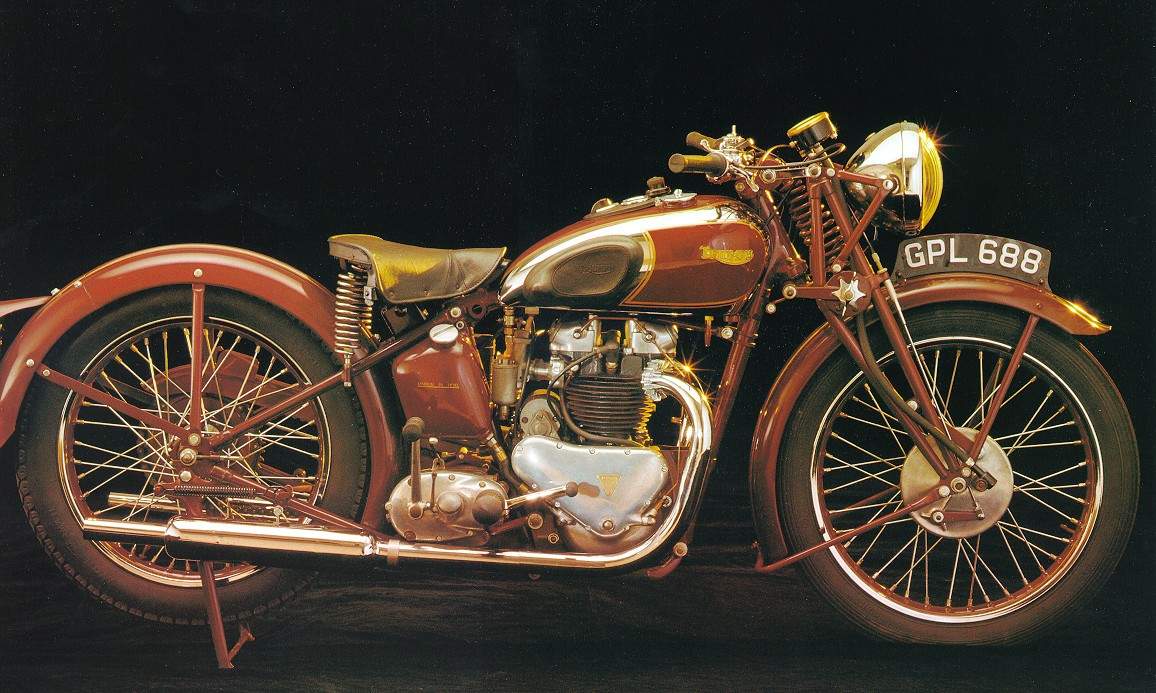
|
|
|
|
|
|
Classic Bikes
Custom Bikes
Individual
Racing Bikes AJP
AJS
Aprilia
Ariel
Avinton / Wakan
Bajaj
Benelli
Beta
Bimota
BMW
Brough Superior
BRP Cam-Am
BSA
Buell / EBR
Bultaco
Cagiva
Campagna
CCM
CF Moto
Combat Motors
Derbi
Deus
Ducati
Excelsior
GASGAS
Ghezzi Brian
Gilera
GIMA
Harley Davidson
Hero
Highland
Honda
Horex
Husaberg
Husqvarna
Hyosung
Indian
Jawa
Kawasaki
KTM
KYMCO
Laverda
Lazareth
Magni
Maico
Mash
Matchless
Mondial
Moto Guzzi
Moto Morini
MV Agusta
MZ / MuZ
NCR
Norton
NSU
Paton
Peugeot
Piaggio
Revival Cycles
Roland Sands
Royal Enfield
Sachs
Sherco
Sunbeam
Suzuki
SWM
SYM
Triumph
TVS
Ural
Velocette
Vespa
Victory
Vincent
VOR
Voxan
Vyrus
Walt Siegl
Walz
Wrenchmonkees
Wunderlich
XTR / Radical
Yamaha
Zero
Video
Technical
Complete Manufacturer List
|
Triumph Speed Twin 500
THIS BURGUNDY BEAUTY MAY look like a motorcycle, but to the people who first clamped eyes on it when it was introduced back in 1937, it looked more like a new beginning. To Edward Turner, that human bundle of enthusiasm and impatience who was Triumph's managing director and chief designer, it was a fast, smooth Twin that looked like a Single. It was the machine to lure British riders away from their beloved and trusted Thumpers, and onto multi-cylindered bikes. To the riding public, who first saw the all-new 1938 Triumph Speed Twin at Britain's Olympia Show in late 1937, it oozed style and sophistication, and it promised performance, all in a package that was well-constructed, light and as lean as a whippet. Today, it still looks right. It is the progenitor of the fabulous Triumph Bonneville-even, one could argue, the progenitor of the 1991 line of modern Triumph motorcycles. It was the Japanese in the 1960s who adopted the notion that for any given displacement, more pistons, spinning more quickly, would produce more power, more smoothly, but this Triumph is the product of the same sort of thinking. Triumph was an old-line firm, founded in Coventry as a bicycle manufacturer by a pair of German immigrants in 1897. The firm's first motorcycle, essentially a bicycle powered by a clip-on Minerva engine, was produced in 1902. For a time, J.A.P. and Fafnir engines also were employed, but by 1903, the firm was designing its own engines. A Triumph powered by one of those engines recorded a win at the Isle of Man TT as early as 1908. By 1913, Triumph's engineers were experimenting with a 600cc vertical-Twin, but when Europe erupted in war in August. 1914, development ceased. After the war, the company stuck with Singles in both side-valve and ohv configurations. A 633cc vertical-Twin-powered machine was produced in 1933, but was stodgy in appearance and failed to generate buyer enthusiasm. It quietly disappeared. That's when Turner entered the picture. Triumph, beset by severe financial difficulties, was taken over by new owners in 1936, and Turner was installed at the top of the company's hierarchy. He, and with him, the company, went from strength to strength. The first of those strengths was the 1938 Speed Twin, which, quite literally, turned the company around. The bike you see here, a 1947 model, is, with the exception of its post-war telescopic fork and 19-inch front wheel, basically identical to the 1938 model that, like all pre-war Speed Twins, used a girder fork and a 20-inch front wheel. Triumph lore has it that Turner cribbed the design of the Speed Twin's engine from that of the Riley Nine automobile, an example of which he owned. Wherever the design came from, the Triumph appeared with a 63mm bore and 80mm stroke yielding 498cc of displacement. Its cylinder head was cast iron, and its compression ratio was 7:1. It breathed through a single Amal carb with a minuscule throat opening. Ah, but the engine was smooth, and it produced 28 horsepower-four more than a Single of comparable size. Depending upon which road test you read, and upon how much tailwind assistance the bike received, this first Speed Twin was capable of between 94 and 107 miles per hour. Average fuel consumption of 65 mpg was claimed. These figures satisfied an enthusiastic public. The Speed Twin prospered, and production of bikes carrying that model name continued through 1966. In all, nearly 45,000 examples were built, helping to establish Triumph as the world's most prestigious motorcycle manufacturer. The bike you see here was bought last year by Beverly Hills architect Lucian T. Hood for $5000, and was recently restored by the Time Machine Motorcycle Works in Costa Mesa, California. The bike was acquired from its second owner in fairly original shape, missing a few bits and pieces and showing 21,263 miles on its odometer. Its value now, polished and perfect, right down to the brass Terry tag on the rear of its saddle, is approximately $15,000. How original is it?. Well, its pistons are 7.8:1 units from a Tiger 100, its rear fender stays are handmade replacements, its leather seat cover is a custom item, and the aluminum cam plate in its transmission has been replaced by a more durable steel plate. But the rest of it? Well, take a look. And if. in looking, you feel transported back to the days when men were men and streetbikes were kick-started, you're on the right track. This kind of simplicity, design excellence and quality of assembly are the elements that assigned Triumph Twins their legendary status. And if the new line of Triumphs marks another new beginning, another chance at legend, there is every reason to argue that it has this previous new beginning to thank for the opportunity. Source Cycele 1984 
|
|
|
Any corrections or more information on these motorcycles will be kindly appreciated. |